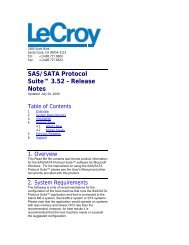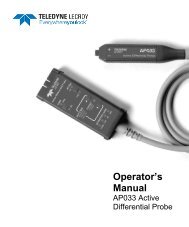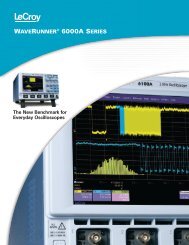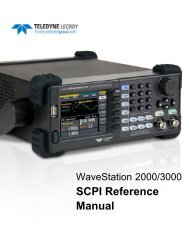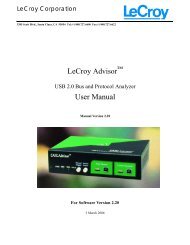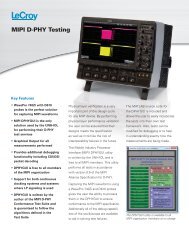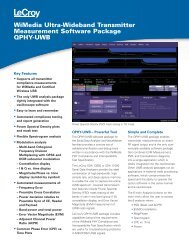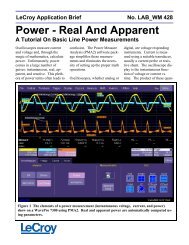Using a Digital Oscilloscope for Signal Analysis - Teledyne LeCroy
Using a Digital Oscilloscope for Signal Analysis - Teledyne LeCroy
Using a Digital Oscilloscope for Signal Analysis - Teledyne LeCroy
You also want an ePaper? Increase the reach of your titles
YUMPU automatically turns print PDFs into web optimized ePapers that Google loves.
WHITE PAPER<br />
<strong>Using</strong> a <strong>Digital</strong> <strong>Oscilloscope</strong> <strong>for</strong> <strong>Signal</strong><br />
<strong>Analysis</strong> including a Practical Example of<br />
PLL Characterization<br />
Dr. Michael Lauterbach<br />
Wayne Swirnow<br />
<strong>LeCroy</strong> Corporation<br />
The oscilloscope has been a primary tool <strong>for</strong> electronic design engineers<br />
since the invention of that instrument, many years ago. The first decades<br />
of oscilloscopes were “analog” in nature. Their fundamental technology<br />
was the front end amplifier, sweep generator and—most particularly—<br />
the phosphor which was used to coat the screen of a CRT. That phosphor<br />
served as a memory element that briefly held the shape of the signal on<br />
the CRT <strong>for</strong> the viewer. The value of the scope was in its ability to<br />
trigger many times per second and overlay the phosphorescent images<br />
on the screen. In<strong>for</strong>mation concerning the waveshape of the signal was<br />
transferred via viewing the signal (sometimes using a hood to eliminate<br />
light sources and at other times using a camera). The analysis was done<br />
in the brain of the human who viewed the in<strong>for</strong>mation and extracted<br />
insights from the waveshape.<br />
Back in the early 1980’s the analog oscilloscope began to give way to a<br />
new type of instrument a <strong>for</strong> capturing and measuring signals called the<br />
digital oscilloscope. The digital scope sometimes called the DSO<br />
(<strong>Digital</strong> Storage <strong>Oscilloscope</strong>) offered the user the ability to capture a<br />
wave<strong>for</strong>m by converting the analog data to digital numbers, then<br />
displaying the data points on the CRT screen. Because all the data was<br />
now stored in memory there were several advantages to this technology<br />
with regard to viewing and analyzing the wave<strong>for</strong>m. Engineers who<br />
were looking at single shot or low repetition rate events found that the<br />
DSO provided a way to capture, store and view a very brightly displayed<br />
wave<strong>for</strong>m regardless of how slow the rep rate was. Also, the DSO did<br />
not suffer from the wave<strong>for</strong>m decay or blooming display issues which<br />
were problematic with analog storage oscilloscopes. The DSO’s digital<br />
<strong>for</strong>mat gave the engineer the ability dive further into analysis of the<br />
wave<strong>for</strong>m than earlier “viewing technologies.” New tools to per<strong>for</strong>m<br />
wave<strong>for</strong>m measurements automatically like pulse parameters removed<br />
subjectivity and variability caused by the engineer “reading the screen”<br />
and increased measurement accuracy. There were feature sets like pre<br />
and post trigger display, multiple zoom capability, and wave<strong>for</strong>m<br />
analysis such as averaging, basic math and FFT which the basic analog<br />
scope simply could not do. These tools made wave<strong>for</strong>m analysis<br />
available to every engineer without the need to use standalone digitizer<br />
cards and write software <strong>for</strong> analyzing the data.
Some applications are still best suited to use of oscilloscopes that can<br />
quickly trigger and present of a view of the signal—using a time<br />
constant that allows many signals to be overlaid on the screen<br />
simultaneously. The fastest analog storage scope on the market today<br />
can trigger up to 1,000,000 times per second and draw each individual<br />
signal on the screen in real time, with a variable decay rate <strong>for</strong> the<br />
phosphorescence. But the market <strong>for</strong> such scopes is dying away,<br />
primarily because design/test engineers can no longer extract sufficient<br />
in<strong>for</strong>mation from a signal by viewing it. In many applications, “viewing<br />
tools” are becoming a dead end. They take the engineer a short distance<br />
in the right direction, but give no way to get where he really needs to go.<br />
As an example, an engineer might be tasked with verifying the<br />
per<strong>for</strong>mance of a 133 MHz clock used to transfer data to/from a microprocessor.<br />
One key question is whether the clock meets certain test<br />
standards <strong>for</strong> cycle-to-cycle jitter. Imagine an engineer trying to visually<br />
observe 133 million cycles of the wave<strong>for</strong>m per second on the screen<br />
and trying to decide “by eyeball” if the clock meets the spec. Impossible.<br />
Actually, if there is a gross error in the clock it could be obvious the<br />
signal does NOT meet the test standard, but in the more normal case it<br />
isn’t clear from observing a long, complex waveshape whether the<br />
circuit is working properly (or not).<br />
So here is the conundrum. How does a digital oscilloscope, which can<br />
capture a large amount of highly accurate data—which contains the<br />
answer the user needs—display that data in a way that extracts the<br />
desired content concerning a complex signal structure. If the in<strong>for</strong>mation<br />
is that the signal “passes” a certain test standard, the scope could<br />
simply display a text message. But if the circuit is not working properly,<br />
how can the myriad in<strong>for</strong>mation available in the scope be displayed in a<br />
way that gives insight to the user This brings us to the concept of<br />
“WaveShape <strong>Analysis</strong>” which is the ability of an oscilloscope to represent<br />
complex data using a <strong>for</strong>mat which is NOT the usual voltageversus-time<br />
wave<strong>for</strong>m. The new view of the data should allow the<br />
engineer to “discern by viewing” and “confirm by measuring” using the<br />
new view of the data—just like he did in the “old days” by viewing the<br />
raw signal shape and putting cursors on it to make a measurement. This<br />
type of analysis is based on being able to view wave<strong>for</strong>ms in the time,<br />
frequency, statistical and parameter modulation domains. Only by using<br />
this broad range of views can the oscilloscope user gather a complete<br />
understanding of the circuit/device per<strong>for</strong>mance. WaveShape <strong>Analysis</strong><br />
involves the ability to use powerful math functions to trans<strong>for</strong>m signals<br />
from one domain to the other. All of this processing has to be easily
accessible, understandable, and lightning fast, otherwise it will not be<br />
used. Modern digital oscilloscope have finally matured to the point<br />
where they can enable engineers to quickly acquire, measure, and<br />
analyze and present to the user in simple to view <strong>for</strong>mats vast amounts<br />
of data. The scope can extract “in<strong>for</strong>mation” from “raw data.”<br />
The classic oscilloscope measurement provides a view of voltage as a<br />
function of time. While this basic measurement tool has stood the test of<br />
time, today’s complex signals require much greater WaveShape <strong>Analysis</strong><br />
capabilities than simple cursor or parameter measurements in order to<br />
extract the useful in<strong>for</strong>mation. <strong>Signal</strong>s today are too complex to discern<br />
if they are correct simply by looking at the mass of data on the scope<br />
screen and it has become difficult confirm their behavior by measuring<br />
using conventional parameters because many these parameters cannot<br />
effectively or completely operate on long complex data sets. Figure 1<br />
shows a simple but powerful example of WaveShape <strong>Analysis</strong>. Often,<br />
the key characteristics of a signal are computed as pulse parameters such<br />
as frequency, duty cycle or the timing skew between two edges. Early<br />
digital scopes would simply display the latest measurement of the<br />
parameters. Several years ago oscilloscopes began displaying statistics<br />
including the high, low average and rms values of parameters. But the<br />
user gets little insight into the source of circuit faults from these<br />
numbers. They simply report if the signal meets or fails the specification.<br />
A histogram is a new view of the parameter data. It is a bar chart<br />
that shows how often each value of the parameter occurred. This new<br />
view (a re-presentation of the data) allows simple viewing and easy<br />
measurements tha t extract in<strong>for</strong>mation from a complex set of raw data.<br />
The “histicon” (icon size view of a histogram) of the frequency parameter<br />
in Figure 1 shows the basic frequency is not stable—and the<br />
“bathub” shape is an immediate indication that the frequency variation<br />
is due to a sinusoidal modulation (<strong>for</strong> more in<strong>for</strong>mation on interpreting<br />
histogram shapes, there are application notes at www.lecroy.com). The<br />
Gaussian shape of the duty cycle histogram means this parameter has a<br />
central value which is being affected by noise. The skew between<br />
channel 3 and channel 4 is a flat histogram. This indicates there is an<br />
equal chance of timing skew, over a certain range of times, between the<br />
two channels. The user gets immediate in<strong>for</strong>mation from a straight<strong>for</strong>ward<br />
view of each distribution and furthermore can make simple<br />
measurements. The most advanced oscilloscopes have very fast data<br />
throughput that enables the display of up to eight simultaneous histicons<br />
of any parameter.
Figure 1 Histicons (histogram icons) showing frequency modulation, noisy<br />
duty cycle and a flat distribution of timing skew.<br />
The ability to extract useful in<strong>for</strong>mation from complex signals is further<br />
complicated by the length of the wave<strong>for</strong>m record. A few years ago a<br />
DSO with real time or single shot sampling rate of 1GS/s was<br />
considered reasonably fast. If a 1 GS/s scope, capturing one sample per<br />
nanosecond, recorded a short simple wave<strong>for</strong>m using 50 kpoints, the use<br />
of a 20 GS/s scope (20 data points per nanosecond) will require 20 times<br />
more memory, 1 Mpoint, to capture the same length signal. Of course<br />
the newer scopes with higher sampling rates capture a signal much more<br />
accurately and show more signal detail. But not only does the oscilloscope<br />
now need to have much longer record length just to cover the<br />
same time span but it also needs a high speed data path to handle this<br />
long array and be able to per<strong>for</strong>m calculations on a large data file.<br />
Simply having long memory in an oscilloscope is not enough.<br />
The challenge <strong>for</strong> T&M companies is to create a DSO with high<br />
sampling rates, long memory and very specialized hardware/software<br />
infrastructure which has been designed to acquire, move, process and<br />
extract useful in<strong>for</strong>mation from long complex data records. This process<br />
must be fast, so the engineer is not kept waiting <strong>for</strong> the process to<br />
complete, there<strong>for</strong>e usability of the instrument stays high and the<br />
engineer stays productive. <strong>LeCroy</strong> has addressed this challenge through<br />
the invention of new extremely fast, streaming architecture—named<br />
X-Stream technology. The new technology makes measurements<br />
10–100 times faster than previously possible, to allow more accurate<br />
measurements, faster measurements and the ability to decrease deadtime<br />
when making measurements (thereby increasing the likelihood of being<br />
able to measure an intermittent fault). Let’s look at a practical example<br />
of a moderately complex measurement—the characterization of per<strong>for</strong>mance<br />
of a phase locked loop.
A Practical Example<br />
of <strong>Analysis</strong>—<br />
Characterizing<br />
Per<strong>for</strong>mance of<br />
a PLL<br />
In Figure 1 the scope user sees a statistical domain view of signal<br />
characteristics that gives insight into the wave<strong>for</strong>m. A different type of<br />
WaveShape <strong>Analysis</strong>, in the time domain is shown in Figure 2. The<br />
acquired wave<strong>for</strong>m is 200 usec long and is sampled at 8 Gs/s—<br />
generating 1.6 million points of data. The signal in the upper half of the<br />
screen is 100,000 cycles of a phase locked loop. During the acquisition<br />
window, the PLL is “kicked” from a low frequency to a higher one.<br />
While the upper trace presents the usual voltage-vs-time oscilloscope<br />
display, the lower trace is a new presentation of the data. Every period<br />
of the PLL is measured and the lower trace tracks the PLL frequency<br />
(1/period <strong>for</strong> each of the 100,000 periods) versus time. The new view of<br />
the data shows the frequency begins at a stable, low value then there is<br />
a step which overshoots and settles to a new, higher frequency. We call<br />
this trace a “JitterTrack.” It is easy to view the timing changes of a<br />
circuit with this type of trace and to make measurements such as the<br />
amplitude of the frequency shift (70.2 kHz), base/top frequencies<br />
(9.638/10.0340 MHz), rise time of the frequency step (2.50112 usec)<br />
and overshoot (62.32%).<br />
The PLL response shown in Figure 2 is fairly simple. In general, the<br />
output phase of a PLL will respond to changes in the input phase–but<br />
only if those changes are within the bandwidth range the PLL. Input<br />
changes that occur at low frequencies are passed to the output but high<br />
frequency changes are too fast <strong>for</strong> the PLL to respond. An engineer will<br />
often want to characterize the response curve of a PLL versus frequency.<br />
This is sometimes called the PLL loop bandwidth, or the jitter transfer<br />
function of the PLL. This brings us to a third type of view which can be<br />
used to gain insight into circuit behavior—the view in the spectral/<br />
frequency domain.<br />
We can measure the PLL loop bandwidth by applying an input signal<br />
that contains a step change in phase. This will allow us to measure the<br />
step response of the PLL. The PLL impulse response can obtained by<br />
differentiating the step response. The FFT of the impulse response is the<br />
frequency response of the PLL. Figure 3 shows the measurement of<br />
the frequency response of the input signal. The top trace (left side) is the<br />
input reference signal—a 66.67 MHz signal with a 2 radian step in<br />
the phase at the center of the trace. The JitterTrack (second trace on left)<br />
of TIE (Time Interval Error) actually shows the step. This is a very<br />
powerful WaveShape <strong>Analysis</strong> tool, “Parameter Modulation View”<br />
taking the large and complex data set with a phase shift in the top trace<br />
and re- presenting it in a simple to discern and measure processed trace.<br />
We have just extracted very useful in<strong>for</strong>mation from the input signal.
Figure 2 The upper trace is 100,000 cycles of a PLL. The lower trace is <strong>for</strong>med from a series of numbers<br />
which track the frequency of the PLL. This JitterTrack presents a simple view of a step change in PLL<br />
frequency. Parameters measure the characteristics of the frequency shift.<br />
This is differentiated (third trace left) and then processed through an<br />
FFT and averaging to show the frequency response of the input in the<br />
bottom trace. This is the input excitation to the PLL and it is a spectrally<br />
flat input out to 5 MHz (to within about ± 1.5 dB).<br />
In Figure 3 (right half) the output signal is analyzed. Going through the<br />
identical processing steps the result is the output response of the PLL.<br />
Note that it is a lowpass characteristic with an upper cutoff frequency of<br />
about 3 MHz. There is a broad peak at about 2.5 MHz, after which the<br />
response rolls off. The final step is the divide the output spectrum by the<br />
input spectrum as shown in Figure 4. As these are both logarithmically<br />
weighted, this is the normalized frequency response of the PLL.
Input signal 66.67Mhz<br />
Output signal<br />
Time Interval Error<br />
(Demodulated phase)<br />
Demodulated phase<br />
response<br />
TIE differentiated<br />
(impulse response)<br />
2.5MHz<br />
FFT<br />
.5MHz/div<br />
Figure 3 Input (left side) and output (right side) comparison of PLL”<br />
This type of WaveShape <strong>Analysis</strong> can be extended to measure characteristics<br />
such as phase offset between the input and output wave<strong>for</strong>ms.<br />
Measurements can be made <strong>for</strong> static clock frequencies or in the presence<br />
of spread spectrum modulation.<br />
All of the WaveShape <strong>Analysis</strong> we have applied has been derived from<br />
the raw voltage vs time measurements of the input and output wave<strong>for</strong>ms.<br />
But, as in many applications, the user cares less about the raw<br />
data and is more concerned with in<strong>for</strong>mation concerning component/<br />
circuit per<strong>for</strong>mance. These crucial per<strong>for</strong>mance characteristics can best
Output FFT<br />
Input FFT<br />
Output FFT/Input FFT<br />
Figure 4 Frequency response of a PLL computed by taking the difference (bottom grid) of the logarithmic output and input<br />
responses<br />
be observed from wave<strong>for</strong>m analysis in the time, frequency, statistical<br />
and parameter modulation domains. Current oscilloscopes, which include<br />
these highly integrated WaveShape <strong>Analysis</strong> tools more than pay <strong>for</strong><br />
themselves when it comes to solving problems involving today’s<br />
complex electronic circuits and devices.<br />
For more in<strong>for</strong>mation on X-Stream technology, characterizing PLL’s,<br />
and many other types of measurements, consult www.lecroy.com.



